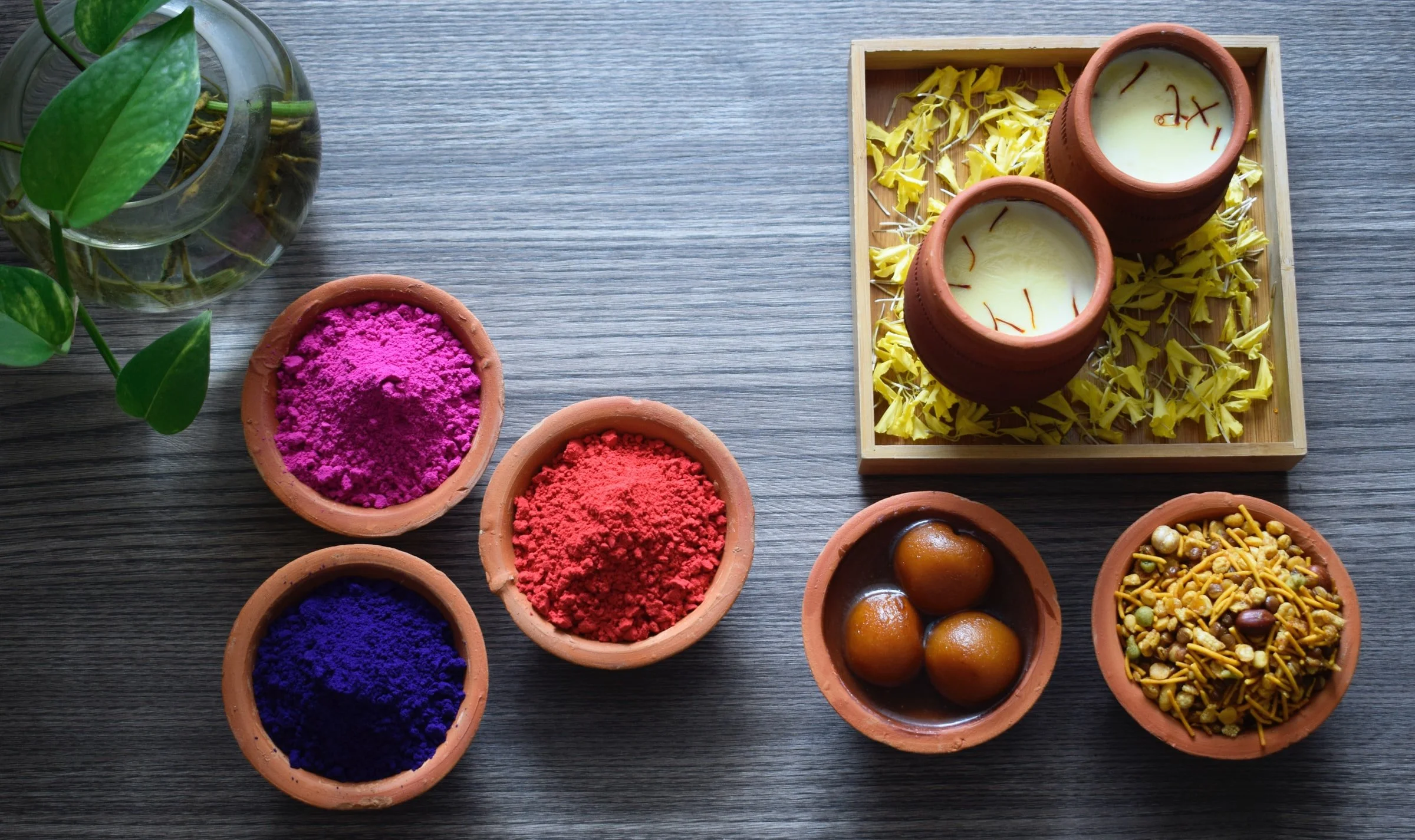OUR GUIDE TO THE INDIAN SPRING FESTIVAL
Holi is most known for its color. We’re talking about bright bursts of gulal, colored powder in every shade of the rainbow. It is playfully thrown by the fistfuls by crowds who gather in the streets and city centers. The air is filled with explosive puffs of dust that blend with bucketfuls of water, showering dancing revelers (and unexpectant passersby) in a kaleidoscope of watercolors.
There’s a lot more nuance to this holiday than gulal. As one of the biggest cultural celebrations in India dating back to the 4th century, Holi is observed by diverse groups of people on every part of the subcontinent—Hindus, Jains, Sikhs, Muslims, Christians, Buddhists and non-religious people—and carries with it history, regional distinctions and evolving traditions. It has become a widely popular festival in the global diaspora.
In many ways, Holi is a communal end-of-winter party hailing the incoming warmer temps, growing spring crops, and overall happier moods that come with sunnier days—complete with springtime’s blooming flowers and twitterpated flirtation. Holi says, “Alvida!” to winter, and greets spring with outstretched arms and beaming faces smeared in color.
a plate of TAGMO’s Ghujia, a delicacy during Holi
HOLI RITUALS
Leading up to the Holi celebration, people prioritize making things right with others, ending conflict, and paying off or forgiving debt—if only banks and student loan holders observed this part of Holi, right!? Generally, it’s a time to refresh old relationships with love and compassion, and to make new friends.
The day begins with Rangwali Holi, an all-out color throwing street party during the day, which is what most non-Hindus are familiar with. Amidst the flying colors, kids and adults fill up buckets, toys and balloons to drench each other, turning the dry powdered colors into a messy blur of bright neon hues. Anyone who dares to go outside is fair game. There’s live street music, dancing and singing as people laugh and play.
A TASTE OF HOLI
Like most South Asian festivals, Holi would be nothing without food and drink to celebrate with others. After people wash off their colors, they get dressed up and visit loved ones where they relax and share food.
There are many different foods that are eaten during Holi that include snacks and treats that require more time to make and are not often eaten en masse, like fried pakora, malpua, namak pare, and pani puri. People share sweets like Mithai & Ghujia, which are an important culinary tradition during Holi. Beverages of choice are Lassis and Thandai, a popular sweet chilled beverage for Holi, made with milk, nuts, spices and saffron that’s enjoyed on its own for kids, and often spiked with booze or infused with cannabis for adults.
HOLI CONTAINS MULTITUDES
The holiday goes by many names. It’s known as the Festival of Love, Spring and Color, and has other regionally specific names and customs. It’s celebrated as Phaguwa in Assam, Dola jātra in Odisha, and Basanto utsav in Bengal.
Elements of Holi are connected to ancient folk religions and celebration of agricultural harvests, fertile land and the hope of abundance. But another element of it is rooted in the Hindu mythology of good conquering evil, which wields misogynistic, caste-based anti-Dalit sentiments. All religious traditions have geographic and historical context, and their stories often reflect the same social issues people deal with in their everyday lives, like anxieties about love, class, race and the looming power of the state.
In Brown Girl Magazine, Jashima Wadehra writes of Holi’s harmful origin story and how the beliefs it’s rooted in have inspired acts of violence by people with privilege against marginalized people, still today. This is not the Holi we celebrate.
Wadehra offers insight into how we can use this time of year to celebrate with loved ones while pushing back against Hindu nationalism and anti-Dalit sentiment.
“Religion and how it is interpreted, taught and passed on is a flawed system but within that system lies the influences of culture and humanity. What may once have been provided in context of religion and caste-ist systems has become a global celebration that brings happiness and connects people through music, color, dance and food — all principles integral to all South Asians.
As we celebrate Holi in multiple forms, we must first acknowledge the flawed conception of the festival but also embrace its progress and evolution into an event that has connected the South Asian Diaspora and other communities in a time where polarized divides are causing such turmoil internationally.”
Jashima Wahehra, “The Death of Holika, What it Signifies and How it Translates to Modern-Day Holi Celebrations”
A BETTER WAY TO CELEBRATE
At TAGMO, we love any excuse to share food and bring people together, especially folks who have been historically marginalized, like women, queer, trans, Indigenous, Black and brown people. Learning about our history—no matter how fraught with discomfort—is key in building better futures where our communities thrive.
As people living in the diaspora, we want to connect with our cultures and families that we are separated from by thousands of miles during an ongoing pandemic that has forever changed the way that we gather. It’s through food and supporting our local communities where we are that we can share the best parts of our cultures, while challenging systems of power that pit us against each other.
Let’s reimagine what Holi can (and should) be: a celebration of love for each other as we bloom and grow in 2022!
HOLI HAI!




